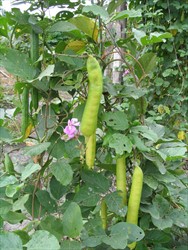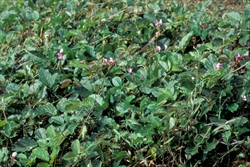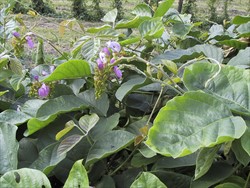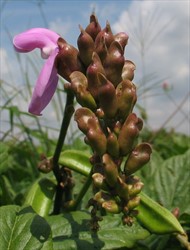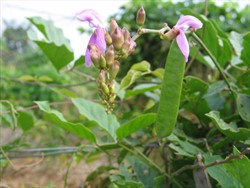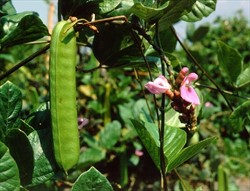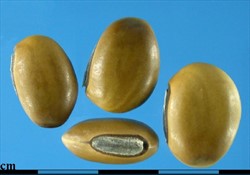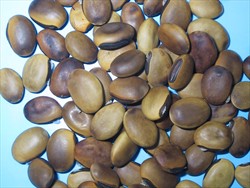Tropical Forages
Family: Fabaceae (alt. Leguminosae) subfamily: Faboideae tribe: Phaseoleae.
Annual or weakly perennial, prostrate to twining herbaceous legume. Leaves trifoliolate, leaflets almost glabrous, ovate, 12‒15 cm long and 8‒11 cm wide, apex acute. Inflorescences axillary racemes, 12‒26 cm long, with white, mostly violet, violet-blue or purple flowers, 2‒2.5 cm long. Pods glabrous, 12‒20 cm long and approx. 1 cm wide, of brown to dark-brown colour, dehiscent with an average of 12 seeds. Seeds light brown to brown, approx. 11 mm long and 8 mm wide, with a black hilum, 6 mm long. There are 1,000‒2,500 seeds/kg with a high level of hardseededness.
English: Brazilian jackbean, Barbicou-bean
Latin America: feijão bravo do Ceará (Brazil); calibolati, frejolón, fríjol espada, haba de playa, mata de playa (Spanish)
Native:
Northern America: Mexico (Campeche, Chiapas, Colima, Guerrero, Jalisco, Mexico, Michoacán, Nayarit, Oaxaca, Quintana Roo, Sinaloa, Sonora, Tamaulipas, Veracruz, Yucatán), USA (Florida (s.))
Caribbean: Antigua and Barbuda, Barbados, Cuba, Haiti, Martinique, St. Vincent and Grenadines (St. Vincent), Trinidad and Tobago, US Virgin Islands
Central America: Belize, Costa Rica, El Salvador, Guatemala, Honduras, Nicaragua, Panama
South America: Argentina (n.e.), Brazil, Colombia, Ecuador, Paraguay, Venezuela (n.)
Forage
is used to improve the value of stubble grazing during the dry season.
Environment
Mainly for green manure, fallow improvement and erosion control but also for fresh or conserved forage. In view of its ample and deep root system, the species can contribute to amelioration of soil structure, to stabilization of erosion prone sites and to nutrient cycling.
Because of the intermediate decomposition and N mineralization rates of the biomass, nutrient release synchronises well with the nutrient demand of annual crops such as maize and rice, when the green manure biomass is incorporated before sowing of the succeeding crop. As a result, N recovery is higher than for most other green manure plants and can reach N recovery rates of mineral N fertilizer.
Other
In poor regions of northeast Brazil, seed is used as human food in times of low food availability.
Soil requirements
Grows well on a wide range of soils, from very acid (pH 4.3) to alkaline (pH 8.0) and is adapted to low fertility. Root growth and biomass production are best in well-drained soils. The species is affected by soil compaction, though less than C. ensiformis. There are indications of salinity tolerance; however, the information available is not conclusive.
Moisture
Adapted to 900‒1,800 mm annual rainfall; survives and can stay green during 5‒6 months of dry period. Regrows quickly at the onset of the rains.
Temperature
Grows in an altitudinal range of 0‒1,800 m asl.
Light
No shade tolerance known.
Reproductive development
Life cycle is 8 months.
Defoliation
First cut can be made 3‒4 months after sowing; 4 months thereafter, a second cut is possible.
Fire
Probably no fire tolerance.
Guidelines for establishment and management of sown forages.
Establishment
Scarification of seeds before sowing is necessary to break hardseededness, e.g. via 30 minutes hot water (80 °C) treatment, and improve germination. is broadcast or sown in rows 40‒50 cm apart and with 20 cm distance between plants in the row, equivalent to 50 kg seed/ha. For seed production, seeds are sown in rows 1 m apart and 20 cm between-plant distance, equivalent to 20‒30 kg/ha of seed. Seed is sown at a depth of 1‒3 cm. Vigorous initial growth.
Fertilizer
Though is adapted to low fertility soils, superphosphate fertilization will enhance establishment and growth.
Compatibility (with other species)
Vigorous growth can suppress weeds.
Companion species
No information available.
Pests and diseases
No information available.
Ability to spread
No information available; probably low.
Weed potential
No information available; probably low.
Nutritive value
There is little information on herbage quality of and no feeding trials are reported. According to one study, the biomass contains 23% CP; 33.5% ADF; 44.1% NDF; 10.6% hemicellulose; 6.52% lignin; 8.42% polyphenols; IVDMD is 69.6%. C/N ratio is 12‒16. Seeds contain 31.9‒41.6% CP, 52.3% carbohydrates, 12.3% crude fibre, 2.8% ash and 1.2% oil. In an evaluation of 47 accessions, CP values in 8-week-old fresh forage ranged between 19 and 25%, and IVDMD between 76 and 85%. Limiting amino acids are methionin, cystein and tryptophan. has high lysine content and could be used as a component in concentrates for poultry and swine.
Palatability/acceptability
In Central America, cattle readily use crop residues improved with in the dry season. There is a report from Nicaragua that herbage is well accepted by sheep and goats.
Toxicity
Seeds of C. brasiliensis contain several antinutritive factors, the toxic amino acid, canavanin, contributing the major part. Other antinutritive components include trypsin inhibitors, concanavalin Br and canatoxin. In Brazil, toxicity of C. brasiliensis herbage to ruminants was reported; however, in Central America under crop residue grazing enriched with contributing with less than 20% to the diet, no negative effects on cattle were observed.
Dry matter
Highly productive under favourable conditions: 3‒8 t/ha/cut; more than one cut per year is possible.
Animal production
Grazing maize stover improved with associated C. brasiliensis can increase dry-season milk production by c. 16% (1 L/cow/day).
2n = 22.
Accession CIAT 17009 yields 570‒680 kg seed/ha.
No information available.
- Drought tolerance.
- Adaptation to a wide range of soils, including acid, low fertility soils.
- High potential for green manure and soil conservation.
- Antinutritive and toxic compounds.
Alvarenga, R.C., Costa, L.M. da, Moura Filho, W. and Regazzi, A.J. (1997) Produção de materia seca e absorção de nutrientes por leguminosas, em resposta a compactação do solo. Revista Ceres 44(254):421–431. ceres.ufv.br/ojs/index.php/ceres/article/view/2435
Barcellos, G.B.S., Almeida, L.M., Moreira, R.A., Cavada, B.S., Oliveira, J.T.A. de and Carlini, C.R. (1993) Canatoxin-, concanavalin A- and canavalin-cross-reactive materials during maturation of Canavalia brasiliensis (Mart.) seeds. Planta 18:397–402. doi.org/10.1007/BF00194437
BFG (The Brazil Flora Group). (2015) Growing knowledge: an overview of seed plant diversity in Brazil. Rodriguésia 66(4):1085–1113. doi.org/10.1590/2175-7860201566411
Burle, M.L., Lathwell, D.J., Suhet, A.R., Bouldin, D.R., Bowen, W.T. and Resck, D.V.S. (1999) Legume survival during the dry season and its effect on the succeeding maize yield in acid savannah tropical soils. Tropical Agriculture (Trinidad) 76:217–221. bit.ly/2Jjm5GO
Carvalho, A.M. de and Sodre Filho, J. (2000) Uso de adubos verdes como cobertura do solo. Boletim de Pesquisa No. 11. Empresa Brasileira de Pesquisa Agropecuária (EMBRAPA) Cerrados, Planaltina, Brazil. infoteca.cnptia.embrapa.br/infoteca/handle/doc/555020
Cobo, J.G., Barrios, E., Kass, D.C.L. and Thomas, R.J. (2002) Decomposition and nutrient release by green manures in a tropical hillside agroecosystem. Plant and Soil 240:331–342. doi.org/10.1023/A:1015720324392
None released to date.
